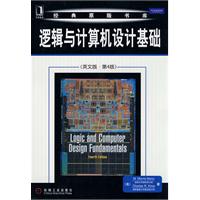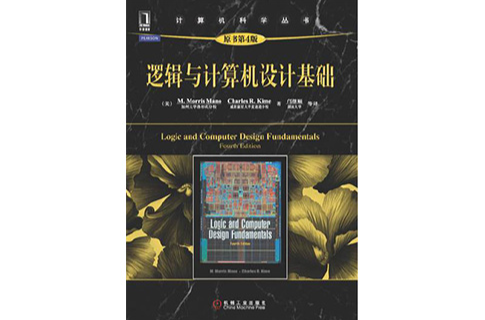邏輯與計算機設計基礎從當代工程觀點講述了邏輯與計算機設計方面的內容,自出版以來已被全球超過25萬人使用。本書以清晰的解釋和逐步延伸的實例來幫助讀者理解內容,實例涵蓋了從簡單的組合套用到建立在RISC核心基礎上的CISC結構,更加重視培養讀者在計算機輔助設計、問題形式化、解決方案驗證和問題解決技巧方面的能力。
基本介紹
- 書名:邏輯與計算機設計基礎
- 作者:(美)馬諾,凱姆
- ISBN:9787111303107
- 定價: 58.00元
- 出版社:機械工業出版社
- 出版時間:2010-4-1
- 開本:16
內容簡介,圖書目錄,
內容簡介
本版更新內容

·新增60個實例和習題。
·新增和修改了40%的習題。
·重新調整和組織了內容以適應不同的課程大綱。
·技術內容的更新包括:
簡要介紹嵌入式系統。
使用Espresso對實用的計算機輔助邏輯最佳化方法進行說明。
簡要介紹MOS電晶體和CMOS電路。
補充了異步互動、同步和亞穩態相關知識。
一種新的控制單元和暫存器傳輸控制設計的圖形表示。
更新了CRT顯示和液晶屏顯示的例子。
包括多核處理器的新型體系結構。
圖書目錄
Preface
Chapter 1
DIGITAL SYSTEMS AND INFORMATION
1-1 Information Representation
The Digital Computer
Beyond the Computer
More on the Generic Computer
1-2 Number Systems
Binary Numbers
Octal and Hexadecimal Numbers
Number Ranges
1-3 Arithmetic Operations
Conversion from Decimal to Other Bases
1-4 Decimal Codes
BCD Addition
1-5 Alphanumeric Codes
ASCII Character Code
Parity Bit
1-6 Gray Codes
1-7 Chapter Summary
References
Problems
Chapter 2
COMBINATIONAL LOGIC CIRCUITS
2-1 Binary Logic and Gates
Binary Logic
Logic Gates
2-2 Boolean Algebra
Basic Identities of Boolean Algebra
Algebraic Manipulation
Complement of a Function
2-3 Standard Forms
Minterms and Maxterms
Sum of Products
Product of Sums
2-4 Two-Level Circuit Optimization
Cost Criteria
Map Structures
Two-Variable Maps
Three-Variable Maps
2-5 Map Manipulation
Essential Prime Implicants
Nonessential Prime Implicants
Product-of-Sums Optimization
Don't-Care Conditions
2-6 Pragmatic Two-Level Optimization
2-7 Multiple-Level Circuit Optimization
2-8 Other Gate Types
2-9 Exclusive-OR Operator and Gates
Odd Function
2-10 High-Impedance Outputs
2-11 Chapter Summary
References
Problems
Chapter 3
COMBINATIONAL LOGIC DESIGN
3-1 Design Procedure
3-2 Beginning Hierarchical Design
3-3 Technology Mapping
3-4 Verification
Manual Logic Analysis
Simulation
3-5 Combinational Functional Blocks
3-6 Rudimentary Logic Functions
Value-Fixing, Transferring, and Inverting
Multiple-Bit Functions
Enabling
3-7 Decoding
Decoder and Enabling Combinations
Decoder-Based Combinational Circuits
3-8 Encoding
Priority Encoder
Encoder Expansion
3-9 Selecting
Multiplexers
Multiplexer-Based Combinational Circuits
3-10 Chapter Summary
References
Problems
Chapter 4
ARITHMETIC FUNCTIONS AND I'-IDEs
4-1 Iterative Combinational Circuits
4-2 Binary Adders
Half Adder
Full Adder
Binary Ripple Carry Adder
4-3 Binary Subtraction
Complements
Subtraction Using 2s Complement
44 Binary Adder-Subtractors
Signed Binary Numbers
Signed Binary Addition and Subtraction
Overflow
4-5 Other Arithmetic Functions
Contraction
Incrementing
Decrementing
Multiplication by Constants
Division by Constants
Zero Fill and Extension
4-6 Hardware Description Languages
Hardware Description Languages
Logic Synthesis
4-7 HDL Representations-VHDL
Behavioral Description
4-8 HDL Representations-Verilog
Behavioral Description
4-9 Chapter Summary
References
Problems
Chapter 5
SEQUENTIAL CIRCUITS
5-1 Sequential Circuit Definitions
5-2 Latches
SR and S R Latches
D Latch
5-3 Flip-Flops
Master-Slave Flip-Flops
Edge-Triggered Flip-Flop
Standard Graphics Symbols
Direct Inputs
5-4 Sequential Circuit Analysis
Input Equations
State Table
State Diagram
Sequential Circuit Simulation
54 Sequential Circuit Design
Design Procedure
Finding State Diagrams and State Tables
State Assitmment
Designing with D Flip-Flops
Designing with Unused States
Verification
5-6 Other Flip-Flop Types
JK and T Flip-Flops
5-7 State-Machine Diagrams and Applications
State-Machine Diagram Model
Constraints on Input Conditions
Design Applications Using State-Machine Diagrams
5-8 HDL Representafon for Sequential Circuits-VHDL
5-9 HDL Representation for Sequential Circuits-Verilog
5-10 Chapter Summary
References
Problems
Chapter 6
SELECTED DESIGN TOPICS
6-1 The Design Space
Integrated Circuits
CMOS Circuit Technology
Technology Parameters
6-2 Gate Propagation Delay
6-3 Flip-Flop Timing
6-4 Sequential Circuit Timing
6-5 Asynchronous Interactions
6-6 Synchronization and Metastability
6-7 Synchronous Circuit Pitfalls
6-8 Programmable Implementation Technologies
Read-Only Memory
Programmable Logic Array
Programmable Array Logic Devices
6-9 Chapter Summary
References
Problems
Chapter 7
REGISTERS AND REGISTER TRANSFERS
7-1 Registers and Load Enable
Register with Parallel Load
7-2 Register Transfers
7-3 Register Transfer Operations
7-4 A Note for VHDL and Verilog Users Only
7-5 Microoperations
Arithmetic Microoperations
Logic Microoperations
Shift Microoperations
7-6 Microoperations on a Single Register
Multiplexer-Based Transfers
Shift Registers
Ripple Counter
Synchronous Binary Counters
Other Counters
7-7 Register-Cell Design
7-8 Multiplexer and Bus-Based Transfers
for Multiple Registers
Three-State Bus
7-9 Serial Transfer and Microoperations
Serial Addition
7-10 Control of Register Transfers
Design Procedure
7-11 HDL Representation for Shift Registers
and Counters-VHDL
7-12 HDL Representation for Shift Registers
and Counters-Verilog
7-13 Microprogrammed Control
7-14 Chapter Summary
References
Problems
Chapter 8
MEMORY BASICS
8-1 Memory Definitions
8-2 Random-Access Memory
Write and Read Operations
Timing Waveforms
Properties of Memory
8-3 SRAM Integrated Circuits
Coincident Selection
8-4 Array of SRAM ICs
8-5 DRAM ICs
DRAM Cell
DRAM Bit Slice
8-6 DRAM Types
Synchronous DRAM (SDRAM)
Double-Data-Rate SDRAM (DDR SDRAM)
RAMBUS DRAM (RDRAM)
8-7 Arrays of Dynamic RAM ICs
8-8 Chapter Summary
References
Problems
Chapter 9
COMPUTER DESIGN BASICS
9-1 Introduction
9-2 Datapaths
9-3 The Arithmetic/Logic Unit
Arithmetic Circuit
Logic Circuit
Arithmetic/Logic Unit
9-4 The Shifter
Barrel Shifter
9-5 Datapath Representation
9-6 The Control Word
9-7 A Simple Computer Architecture
Instruction Set Architecture
Storage Resources
Instruction Formats
Instruction Specifications
9-8 Single-Cycle Hardwired Control
Instruction Decoder
Sample Instructions and Program
Single-Cycle Computer Issues
9-9 Multiple-Cycle Hardwired Control
Sequential Control Design
9-10 Chapter Summary
References
Problems
Chapter 10
INSTRUCTION SET ARCHITECTURE
10-1 Computer Architecture Concepts
Basic Computer Operation Cycle
Register Set
10-2 Operand Addressing
Three-Address Instructions
Two-Address Instructions
One-Address Instructions
Zero-Address Instructions
Addressing Architectures
10-3 Addressing Modes
Implied Mode
Immediate Mode
Register and Register-Indirect Modes
Direct Addressing Mode
Indirect Addressing Mode
Relative Addressing Mode
Indexed Addressing Mode
Summary of Addressing Modes
10-4 Instruction Set Architectures
10-5 Data-Transfer Instructions
Stack Instructions
Independent versus Memory-Mapped I/O
10-6 Data-Manipulation Instructions
Arithmetic Instructions
Logical and Bit-Manipulation Instructions
Shift Instructions
10-7 Floating-Point Computations
Arithmetic Operations
Biased Exponent
Standard Operand Format
10-8 Program Control Instructions
Conditional Branch Instructions
Procedure Call and Return Instructions
10-9 Program Interrupt
Types of Interrupts
Processing External Interrupts
10-10 Chapter Summary
References
Problems
Chapter 11
RISC AND CISC CENTRAL PROCESSING UNITS
11-1 Pipelined Datapath
Execution of Pipeline Microoperations
11-2 Pipelined Control
Pipeline Programming and Performance
11-3 The Reduced Instruction Set Computer
Instruction Set Architecture
Addressing Modes
Datapath Organization
Control Organization
Data Hazards
Control Hazards
11-4 The Complex Instruction Set Computer
ISA Modifications
Datapath Modifications
Control Unit Modifications
Microprogrammed Control
Microprograms for Complex Instructions
11-5 More on Design
Advanced CPU Concepts
Recent Architectural Innovations
11-6 Chapter Summary
References
Problems
Chapter 12
INPUT-OUTPUT AND COMMUNICATION
12-1 Computer UO
12-2 Sample Peripherals
Keyboard
Hard Drive
Liquid Crystal Display Screen
I/O Transfer Rates
12-3 I/O Interfaces
I/O Bus and Interface Unit
Example of I/O Interface
Strobing
Handshaking
12-4 Serial Communication
Synchronous Transmission
The Keyboard Revisited
A Packet-Based Serial I/O Bus
12-5 Modes of Transfer
Example of Program-Controlled Transfer
Interrupt-Initiated Transfer
12-6 Priority Interrupt
Daisy Chain Priority
Parallel Priority Hardware
12-7 Direct Memory Access
DMA Controller
DMA Transfer
12-8 Chapter Summary
References
Problems
Chapter 13
MEMORY SYSTEMS
13-1 Memory Hierarchy
13-2 Locality of Reference
13-3 Cache Memory
Cache Mappings
Line Size
Cache Loading
Write Methods
Integration of Concepts
Instruction and Data Caches
Multiple-Level Caches
13-4 Virtual Memory
Page Tables
Translation Lookaside Buffer
Virtual Memory and Cache
13-5 Chapter Summary
References
Problems
INDEX

